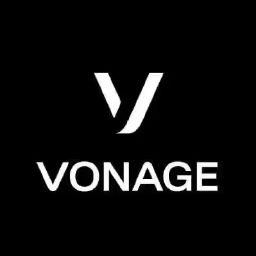Smartlead Alternatives
Explore 10 Smartlead alternatives. An in-depth comparison of features, pricing, and performance to inform your next choice.

Smartlead is a popular choice for email outreach, and for good reason. It excels at managing unlimited email accounts and improving deliverability with its email warm-up feature. Many users find it powerful for scaling their cold email campaigns.
But like any tool, it has limits. Some users find the interface complex or report occasional bugs. We analyzed the best alternatives based on reviews to help you find a better fit. Let's get started.
Add a Digital Worker to Your Sales Team with 11x
For those considering digital workers for sales, 11x offers autonomous agents. These agents can manage tasks like lead research and outreach, letting your sales team concentrate on closing deals.
11x is a go-to-market platform that uses AI agents to handle the sales process. Its agent, Alice, finds prospects, conducts outreach on email and LinkedIn, and updates your CRM. A second agent, Julian, qualifies inbound leads and schedules meetings.
The platform combines functions like data enrichment, outreach, and email warm-up. This approach removes the need for multiple separate tools within a traditional go-to-market stack.
Smartlead Alternatives
The following sections provide a detailed breakdown of each Smartlead alternative. We will examine pricing, core features, and the main advantages and potential drawbacks relative to Smartlead.
1) Lemlist
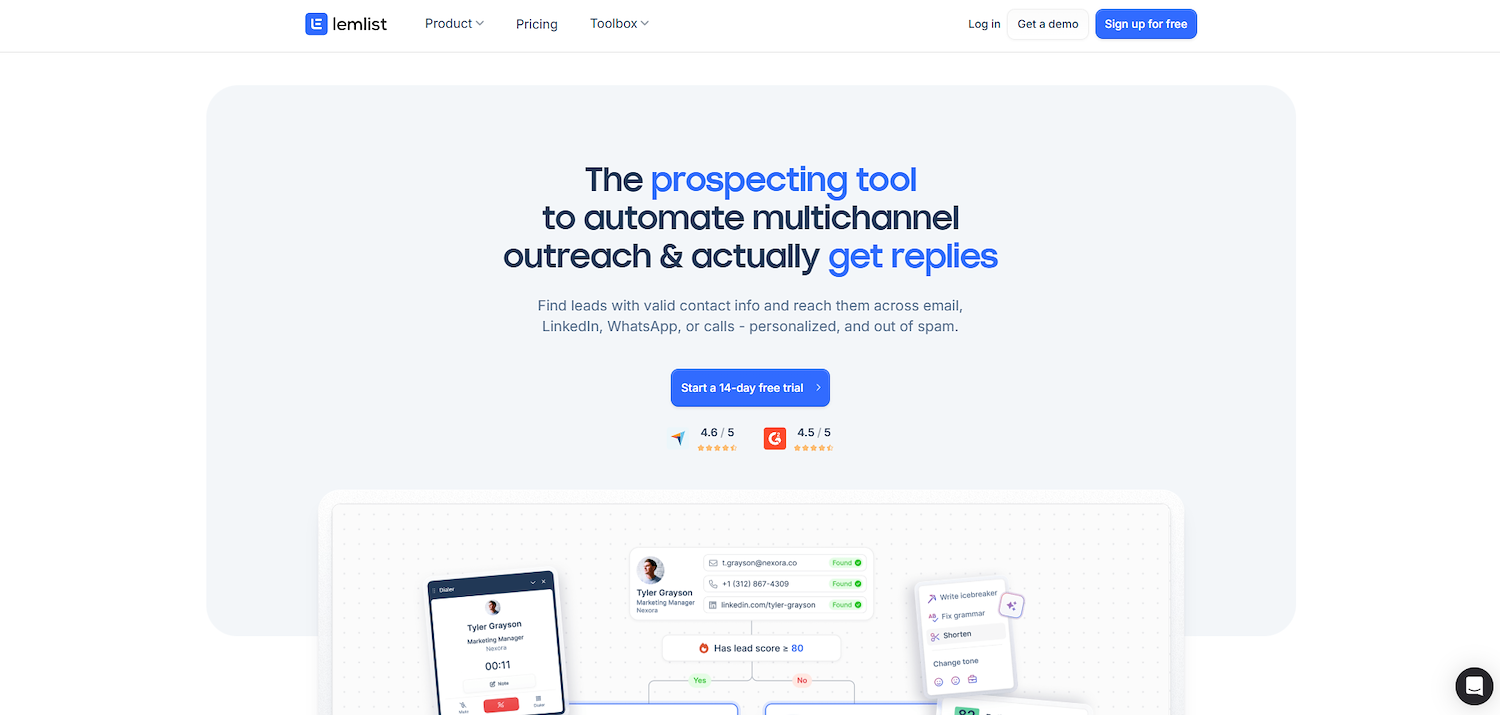
Lemlist is a sales engagement platform to find, enrich, and contact leads. It provides a database with over 450 million contacts and automates sequences on email, LinkedIn, WhatsApp, and phone. AI helps personalize messages at scale.
The platform has a tool for email warm-up to protect deliverability. Teams use it to build lead lists and launch multichannel campaigns from one workspace.
Lemlist's Main Features
- Sources leads from a B2B database of over 450 million contacts and uses one-click waterfall enrichment to find verified emails and phone numbers.
- Automates multichannel outreach sequences that span email, LinkedIn actions, WhatsApp messages, and phone calls from a single platform.
- Uses AI to scrape LinkedIn and websites to automatically insert personalized text, images, and landing pages into messages.
- Provides a built-in email warm-up tool, inbox rotation, and actionable tips to protect sender reputation and improve deliverability.
Lemlist vs. Smartlead: Key Differences
Average Review Score: 4.4/5 stars based on 276 G2 reviews.
- Lemlist automates outreach on email, LinkedIn, WhatsApp, and phone. This offers more channels than Smartlead, which primarily handles email.
- It includes a B2B database of over 450 million contacts for lead sourcing, a feature not found in Smartlead, which requires external lead lists.
- The platform uses AI to insert personalized images and landing pages into messages, providing more dynamic options than the text-based personalization in Smartlead.
- Its integrated workflow combines lead sourcing and multichannel outreach in one tool. This is different from Smartlead's specific focus on email account management and warm-up.
Lemlist vs. Smartlead: Potential Drawbacks
- Lemlist's pricing is on a per-user basis, which can become costly for larger teams. This is different from Smartlead, which supports unlimited email accounts and may be more cost-effective for scaling outreach.
- Its platform includes many features for multichannel outreach. This might add complexity for users who only need a specialized email warm-up tool, where Smartlead has a more specific focus.
- Some users report occasional technical issues, particularly with data enrichment. These bugs can sometimes disrupt prospecting workflows, which may be a concern for teams that need high reliability.
Pricing and Cost-Effectiveness
Lemlist provides a free plan, an Email Pro option at $55 per year, and a Multichannel Expert plan for $79 per month. Its per-user pricing model contrasts with Smartlead's structure, which supports unlimited accounts and can be more economical for large-scale outreach.
2) Instantly
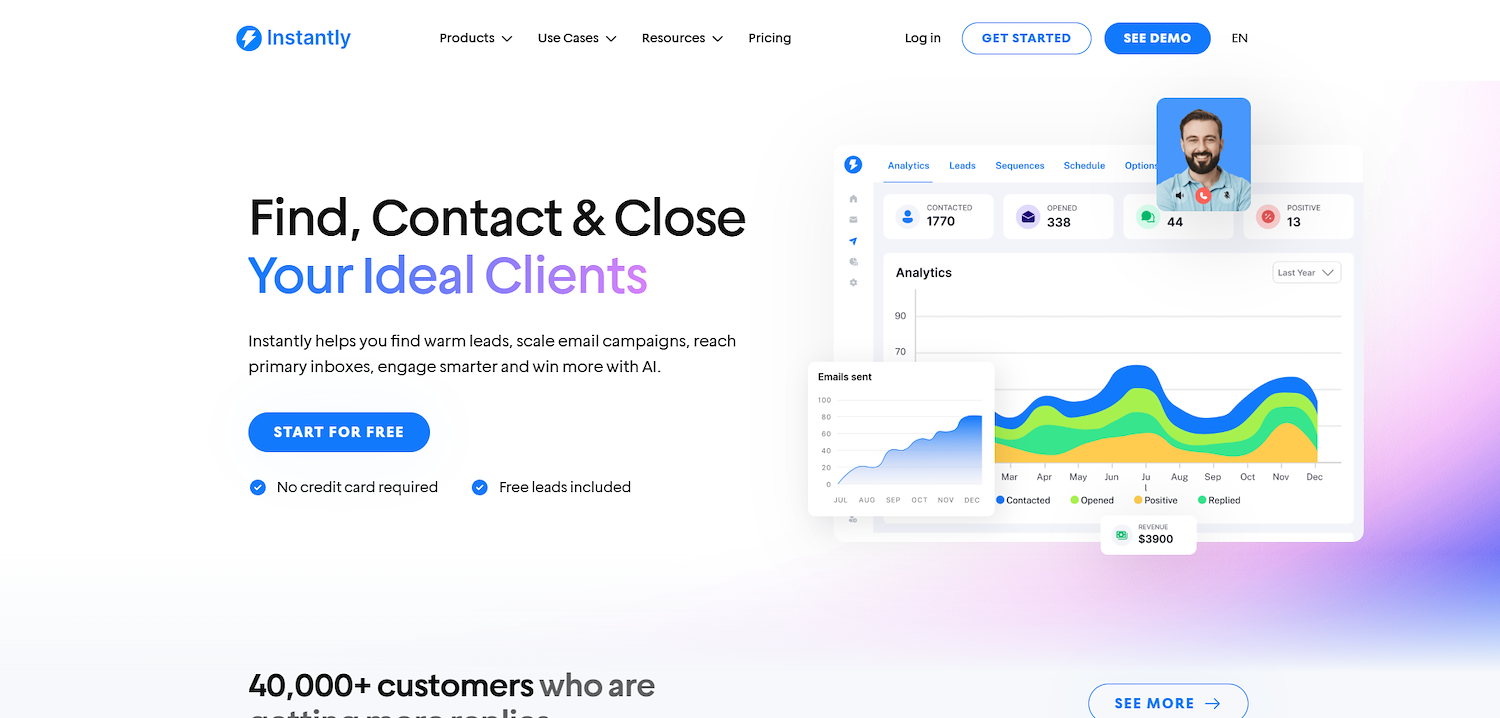
Instantly is a sales-engagement and cold-email platform that helps businesses find and contact clients. It combines an automated outreach engine, a lead database, and AI tools within a single interface.
Users can connect unlimited email accounts and warm up new domains automatically. The platform is built to help sales teams and agencies scale outreach campaigns, find B2B leads, and manage deliverability.
Instantly's Main Features
- Accesses a B2B lead database of over 250 million contacts with filters for technology, company size, and revenue.
- Uses an AI Copilot for creating personalized sequences, checking for spam words, and managing inbox replies.
- Offers one-click purchase and setup of sending domains with pre-configured MX, SPF, DKIM, and DMARC records.
- Includes campaign pipeline analytics to track opportunities, conversions, and revenue from outreach efforts.
Instantly vs. Smartlead: Key Differences
Average Review Score: 4.8/5 stars based on 3,721 G2 reviews.
- Instantly includes a B2B lead database with over 250 million contacts, which is different from Smartlead where users must import their own lead lists.
- The tool's AI Copilot helps create sequences and checks for spam words, offering more AI assistance than Smartlead's text-based personalization.
- It provides one-click purchasing and setup for sending domains, which simplifies a technical process that users handle manually in Smartlead.
- Its campaign pipeline analytics track opportunities and revenue, providing a clearer view of financial ROI compared to Smartlead's focus on deliverability metrics.
- Many users praise its intuitive and simple user interface, which can be an advantage for teams that find Smartlead's platform complex to navigate.
Instantly vs. Smartlead: Potential Drawbacks
- Instantly's reporting features are sometimes considered basic. This is different from Smartlead, which offers more detailed analytics for tracking performance across unlimited email accounts.
- Its pricing model can become costly for large teams. This contrasts with Smartlead, which supports unlimited accounts and is often more economical for large-scale outreach.
- Some users report that email management for many inboxes is less streamlined than in Smartlead. Smartlead includes a master inbox to see all replies in one place, which simplifies handling conversations from hundreds of accounts.
Pricing and Cost-Effectiveness
Instantly offers Growth and Hypergrowth plans at $37 and $97 per month, respectively. This per-workspace model can be cost-effective for smaller teams, while Smartlead’s structure is often more economical for large-scale outreach since it supports unlimited accounts. You can check the detailed pricing on Instantly's official website.
3) Mailshake
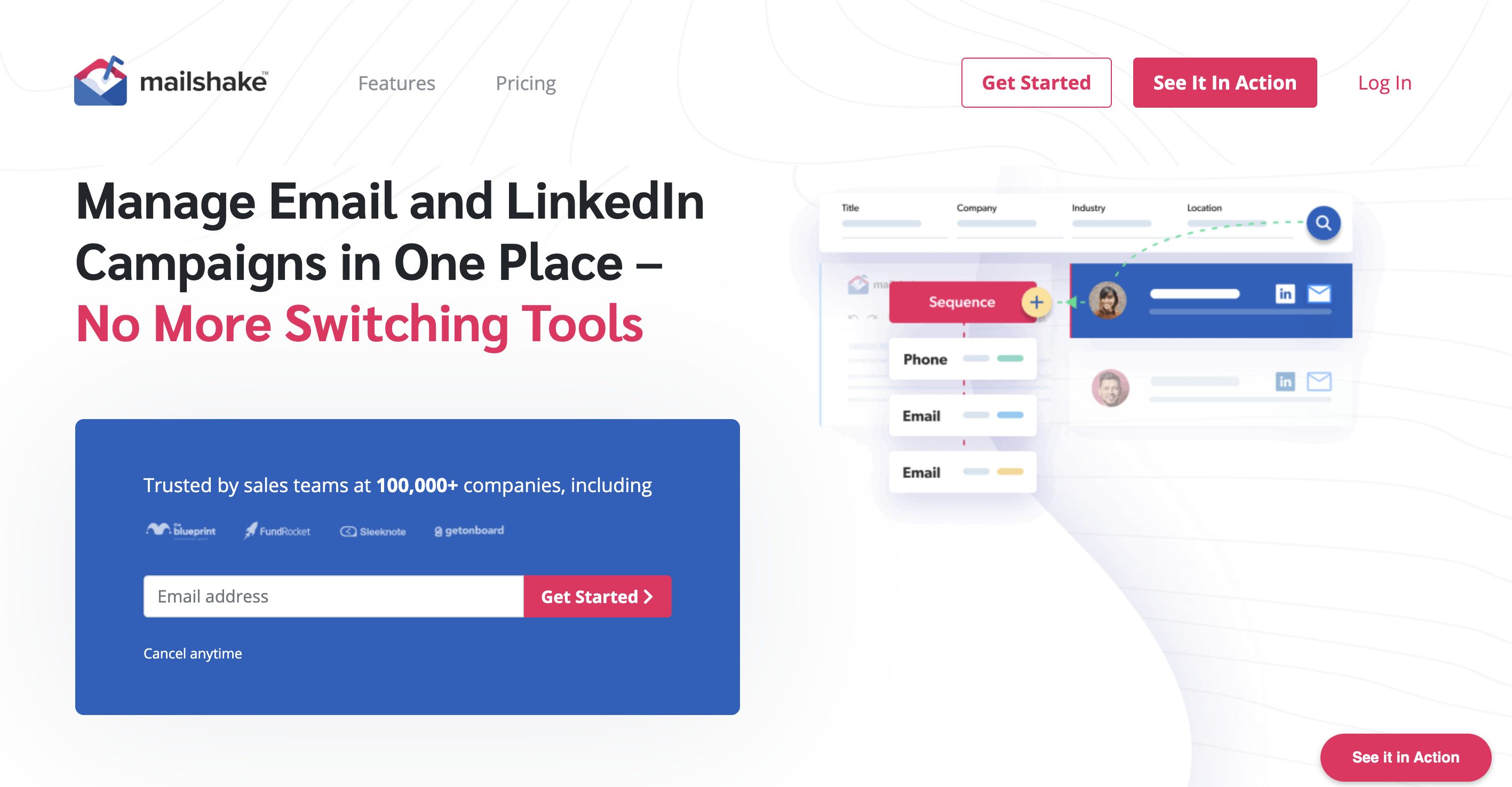
Mailshake is a sales engagement platform for multi-channel outreach across email, phone, and LinkedIn. From a single dashboard, teams automate follow-ups and use AI for content creation. The tool helps users connect with prospects, book meetings, and generate revenue.
Sales leaders, reps, and agencies use it to run campaigns, monitor analytics, and manage high-volume outreach for clients.
Mailshake's Main Features
- It includes a built-in dialer to place cold calls directly from the platform and include calls in campaign steps.
- The tool automates LinkedIn actions, including connection requests, profile views, and messages for multi-channel sequences.
- A lead catcher feature prioritizes highly engaged prospects in a dedicated queue for quick action.
- Its AI email writer, SHAKEspeare, generates and spins copy, subject lines, and A/B variants.
Mailshake vs. Smartlead: Key Differences
Average Review Score: 4.7/5 stars based on 326 G2 reviews.
- Mailshake includes a built-in phone dialer and automates LinkedIn tasks. This provides more outreach channels compared to Smartlead, which primarily focuses on email.
- The tool has a lead catcher feature to prioritize prospects who show high engagement. This helps sales teams focus on the warmest leads, a function different from Smartlead's core design.
- Its AI writer, SHAKEspeare, generates entire email copy variations. This offers more direct content creation assistance than the text personalization options available in Smartlead.
- Mailshake offers native integrations with major CRMs like Salesforce and HubSpot. This allows for a more connected workflow, whereas Smartlead may require other tools for similar CRM syncs.
Mailshake vs. Smartlead: Potential Drawbacks
- Mailshake's pricing limits the number of email accounts per user; its Sales Engagement plan, for example, allows 10 accounts. This is different from Smartlead, which supports unlimited accounts for large-scale outreach.
- Its focus on multichannel outreach means some email-specific features can feel less robust. Smartlead, in comparison, provides a master inbox to manage all replies in one place, which simplifies high-volume campaign management.
- Some users find that the platform offers limited customization for complex email campaigns. Smartlead often provides more detailed control over sequence settings, which helps users with specific outreach needs.
Pricing and Cost-Effectiveness
Mailshake offers plans from $29 to $99 per month, limiting users to between one and ten email accounts. This model can suit smaller teams, while Smartlead's support for unlimited accounts is more economical for large-scale outreach. For current pricing, visit Mailshake's official website.
4) Woodpecker
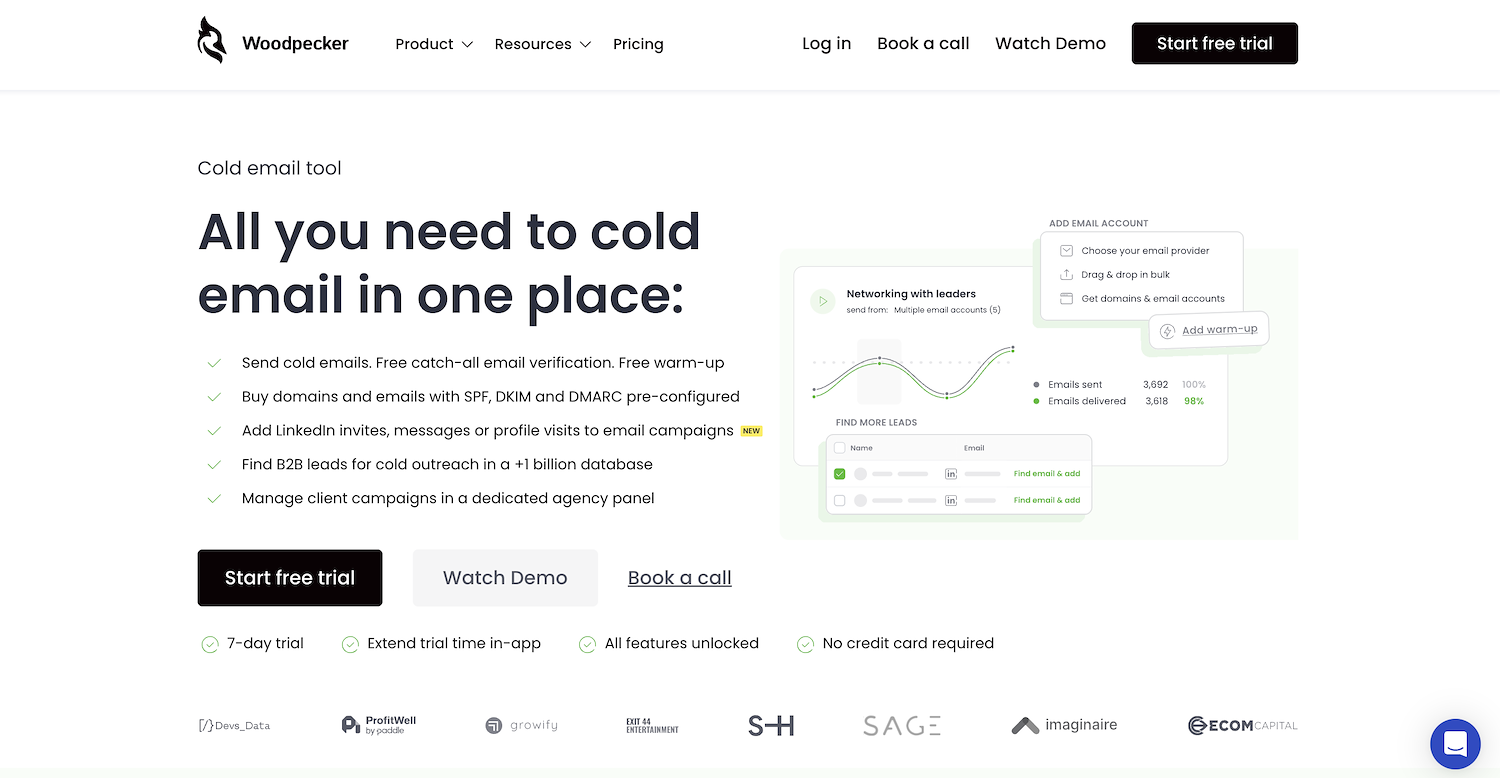
Woodpecker is a cold email tool for B2B companies. It automates outreach campaigns and follow-ups with a focus on deliverability. The platform includes warm-up and recovery features to support this.
Sales teams, lead generation agencies, and recruiters use the tool. It helps them connect with prospects, contact candidates at scale, and manage multiple client campaigns from a single panel.
Woodpecker's Main Features
- Automates LinkedIn outreach by adding invites, messages, and profile visits to sequences.
- Includes an agency panel for managing multiple client campaigns from a single interface.
- Uses adaptive sending to automatically throttle outreach and stay within email provider limits.
- Applies condition-based logic to campaigns for building complex outreach sequences.
Woodpecker vs. Smartlead: Key Differences
Average Review Score: 4.5/5 stars based on 93 G2 reviews.
- Woodpecker includes an agency panel for managing multiple client campaigns from one dashboard, which is different from Smartlead’s focus on individual user campaigns.
- It automates LinkedIn actions like profile visits and messages within sequences, adding an outreach channel not present in Smartlead's email-focused platform.
- The tool applies condition-based logic to campaigns, which allows for more complex outreach paths based on prospect actions compared to Smartlead's more direct sequences.
- Its platform uses adaptive sending to automatically adjust outreach volume and stay within provider limits, offering a different approach to deliverability than Smartlead's warm-up feature.
Woodpecker vs. Smartlead: Potential Drawbacks
- Woodpecker's pricing plans limit the number of prospects you can contact monthly. This is different from Smartlead, which is often selected for high-volume sending capacity without similar direct caps on prospects.
- The tool does not include a master inbox for managing all replies in one place. This can complicate handling conversations from many accounts compared to Smartlead, which centralizes all incoming messages.
- Some users may find its condition-based logic adds complexity for simple campaigns. In contrast, Smartlead’s more direct sequencing can sometimes be faster to set up for standard outreach.
Pricing and Cost-Effectiveness
Woodpecker's pricing starts at $29 per month for 500 prospects, contrasting with Smartlead's model that supports unlimited accounts for high-volume outreach. For detailed pricing, visit Woodpecker's official website.
5) Salesloft
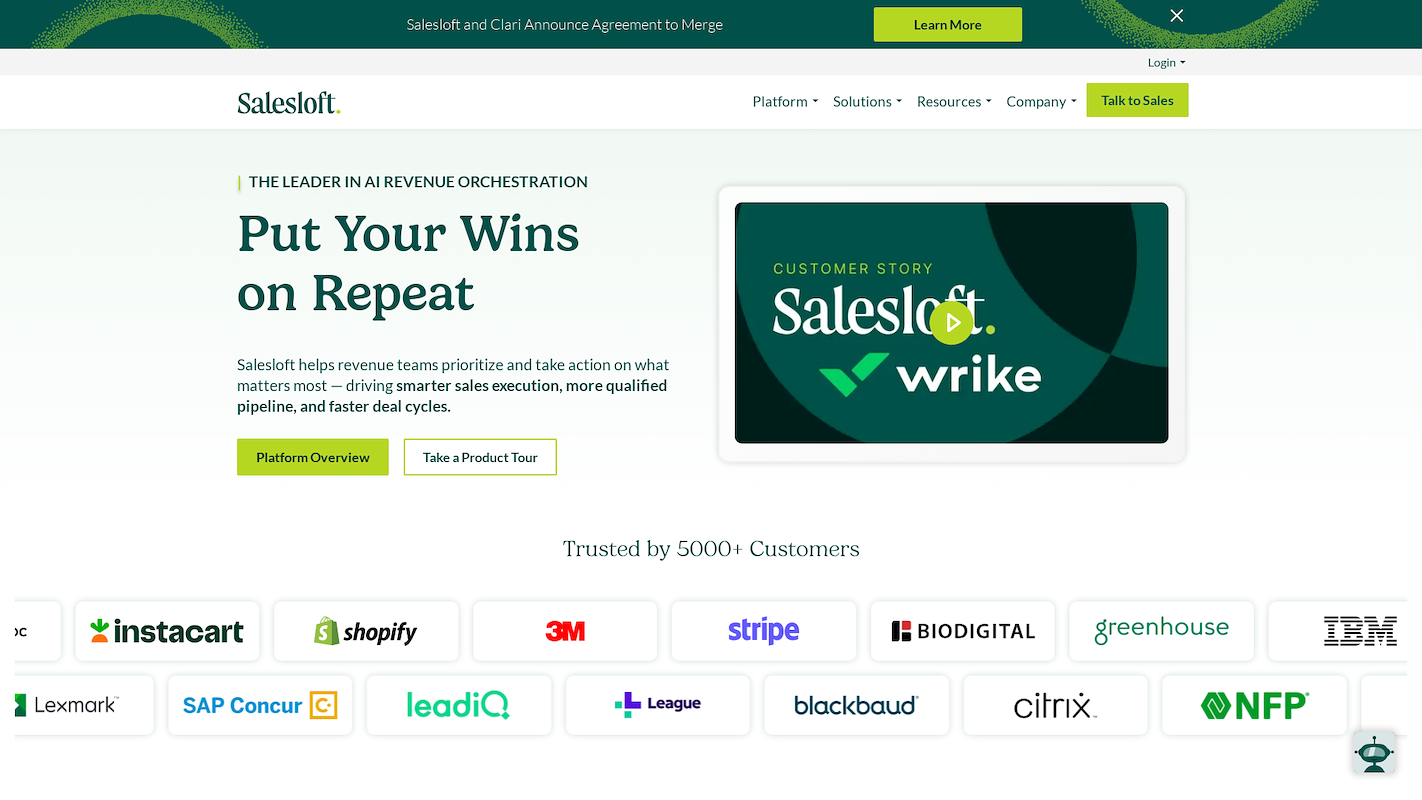
Salesloft is a sales engagement platform for revenue teams. It helps manage the full sales cycle through a combination of email outreach, call automation, and sales analytics. Teams use the platform to execute account-based strategies and manage all communication with buyers.
The tool provides insights from interactions to help sales teams build pipeline and close more deals.
Salesloft's Main Features
- Uses an AI engine, Rhythm, to prioritize and recommend the right actions for sellers at the right moments.
- Provides buyer and seller insights from recorded calls for coaching and performance improvement.
- Offers deal and pipeline management with AI insights into risk, next steps, and velocity.
- Combines real-time deal data, AI, and seller input for more accurate sales forecasting.
Salesloft vs. Smartlead: Key Differences
Average Review Score: 4.5/5 stars based on 4,145 G2 reviews.
- Salesloft uses its AI engine, Rhythm, to prioritize a seller's daily tasks. This offers a different kind of guidance compared to Smartlead, which focuses on email automation and warm-up.
- The platform includes a built-in dialer and call recording for sales coaching. This provides more communication channels than Smartlead, which is primarily an email outreach tool.
- It offers tools for deal and pipeline management with AI-driven forecasting. This helps manage the full sales cycle, while Smartlead concentrates on the initial outreach phase.
- The tool provides conversation intelligence by analyzing call recordings for coaching insights. This feature for team performance improvement is different from Smartlead's analytics, which track email metrics.
Salesloft vs. Smartlead: Potential Drawbacks
- Salesloft's pricing is on a per-user basis, which can be costly for large teams. This is different from Smartlead, which supports unlimited email accounts and is often more economical for scaling outreach.
- The platform does not include a master inbox to manage all replies in one place. This may complicate handling conversations from many accounts, a process Smartlead simplifies with its centralized view.
- As a comprehensive sales platform, it has a higher price point. This might not be cost-effective for teams that only need a dedicated cold email tool, where Smartlead offers a more focused solution.
Pricing and Cost-Effectiveness
Salesloft does not publicly list its pricing, which is common for enterprise-focused platforms. For the most accurate and up-to-date information, we recommend visiting Salesloft's official website to request a quote based on your team's specific needs.
Consider 11x for Your Sales Team
For teams interested in digital workers, 11x offers autonomous agents. They handle lead research and outreach, which frees your sales team to concentrate on deal closure. This approach is a fit for businesses that want to automate parts of their go-to-market strategy.
At 11x, we use AI to manage your sales process. Our agent Alice finds accounts and handles outreach, while Julian qualifies leads and sets up meetings. The platform combines multiple GTM tools into one, removing the need for separate software.
Book a demo to see how it works.
6) Outreach
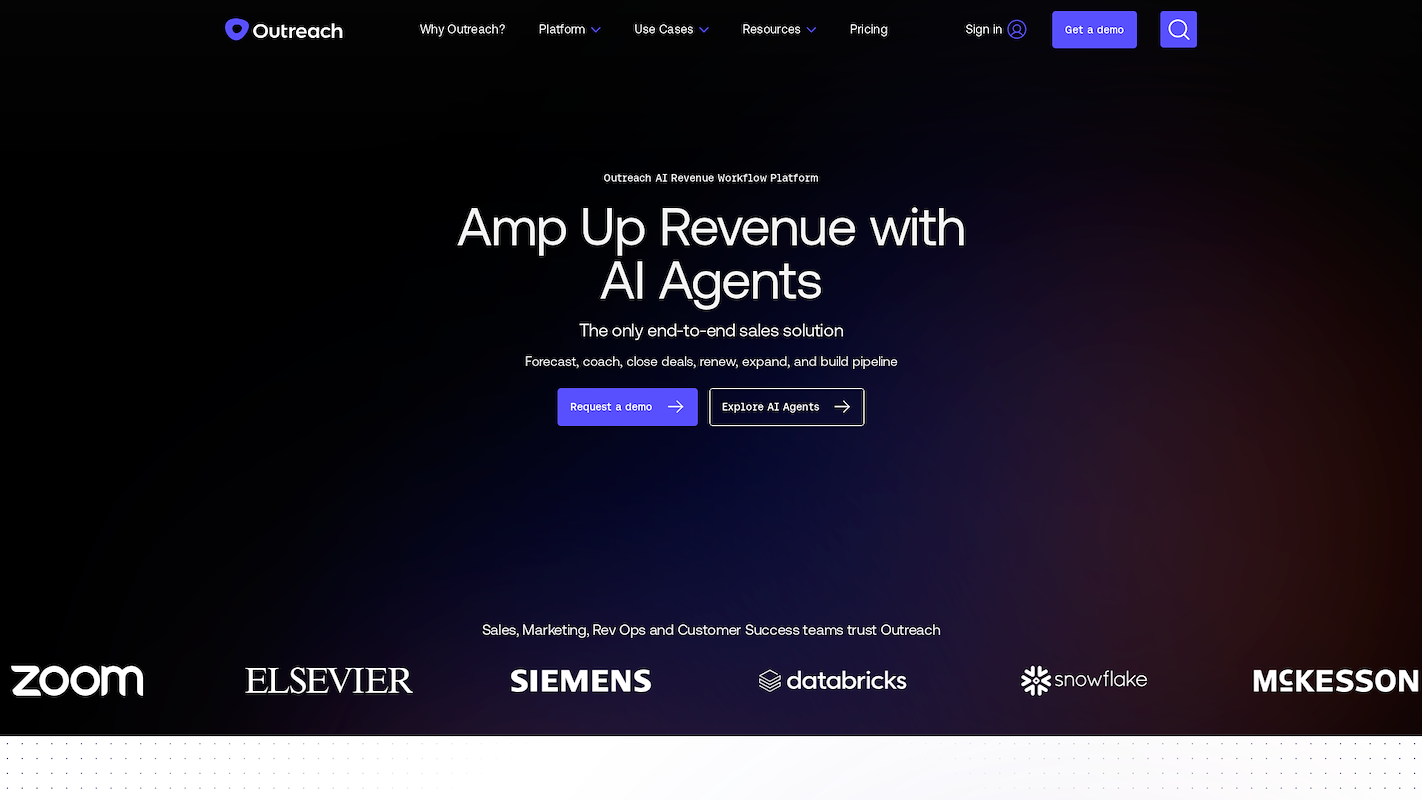
Outreach is a sales execution platform that helps teams drive predictable revenue. It automates customer touchpoints and uses AI insights to guide seller actions. Sales teams use it to build pipeline, manage deals, and forecast revenue, which helps standardize the sales process for enterprise companies.
Outreach's Main Features
- Offers AI-driven rep coaching through Kaia, which provides meeting summaries, Q&A, and analytics.
- Provides pipeline and forecast analytics to predict revenue, identify pipeline gaps, and run scenario forecasts.
- Analyzes meetings, calls, and emails to detect buyer sentiment and topics of discussion.
- Delivers real-time content guidance during live calls with meeting prompts and content cards.
Outreach vs. Smartlead: Key Differences
Average Review Score: 4.3/5 stars based on 3,479 G2 reviews.
- Outreach provides AI-driven sales coaching with its Kaia feature, which analyzes calls. This is different from Smartlead, which focuses on email automation and deliverability.
- The platform includes tools to manage the pipeline and forecast revenue. This offers a broader view of the sales cycle compared to Smartlead's focus on email campaign metrics.
- It analyzes buyer sentiment from calls and emails for deeper insights. Smartlead, in contrast, tracks engagement primarily through opens and clicks.
- The tool gives real-time content suggestions during live sales calls, a direct sales support feature not found in Smartlead's email-focused platform.
Outreach vs. Smartlead: Potential Drawbacks
- Outreach's per-user pricing model can be less cost-effective for teams focused on high-volume email outreach. Smartlead, in comparison, allows for unlimited email accounts, which often makes it a more economical choice for scaling campaigns.
- The platform lacks a master inbox to see all replies in one place. This can make it difficult to manage conversations from many accounts, a task Smartlead simplifies with its centralized inbox.
- Its comprehensive features for the full sales cycle might be excessive for teams that only need a dedicated cold email tool. In contrast, Smartlead provides a more focused solution specifically for email outreach and warm-up.
- Some users note the platform can take a month to implement fully. This may be a factor for teams needing to launch campaigns quickly, where a specialized tool like Smartlead could allow for a faster start.
Pricing and Cost-Effectiveness
Outreach does not publicly list its pricing, which is common for enterprise-focused platforms. For the most accurate information, we recommend visiting Outreach's official website to request a quote based on your team's needs.
7) Reply
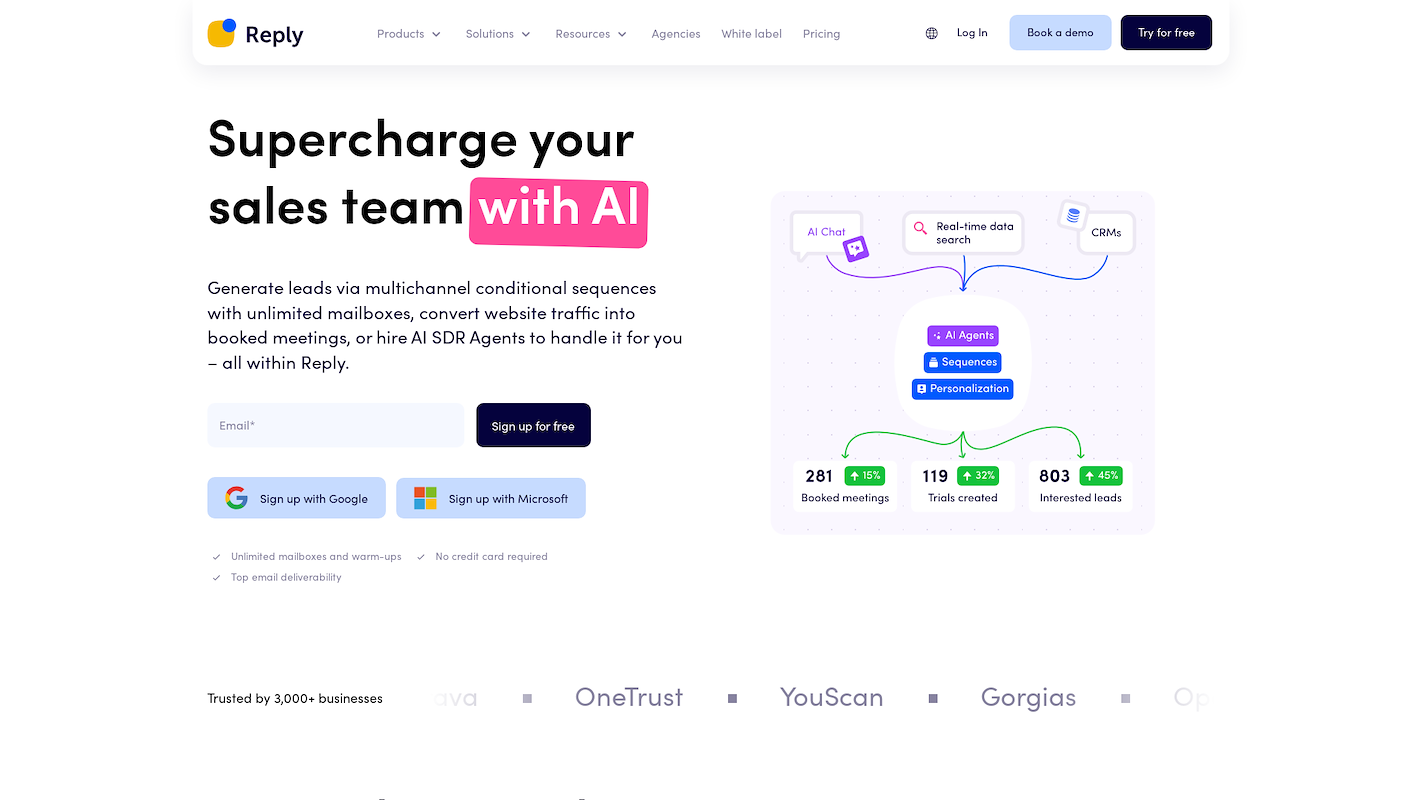
Reply is a sales engagement platform that uses AI to automate contact with prospects. It handles outreach across email, LinkedIn, SMS, and WhatsApp. The platform also includes a B2B database to find new leads.
Sales teams use it for inbound and outbound sales, account management, and agency client acquisition. The tool can schedule meetings automatically and helps manage the sales process.
Reply's Main Features
- Deploys a managed AI SDR agent, Jason, to find prospects, handle replies, and book meetings autonomously.
- Builds multichannel sequences with conditional logic across email, LinkedIn, WhatsApp, SMS, and calls.
- Accesses a B2B database with over one billion contacts and intent signals for list building.
- Uses AI to generate email replies and follow-ups to book meetings automatically from the unified inbox.
Reply vs. Smartlead: Key Differences
Average Review Score: 4.6/5 stars based on 1,458 G2 reviews.
- Reply deploys an AI SDR agent, Jason, to find prospects and book meetings autonomously. This is different from Smartlead, which automates outreach but does not offer a managed AI agent.
- The tool builds multichannel sequences that include email, LinkedIn, WhatsApp, SMS, and calls. This provides more outreach channels than Smartlead's email-focused platform.
- It includes a B2B database with over one billion contacts for list building, a feature not found in Smartlead, where users must import their own lead lists.
- Reply offers an AI chat with video avatars for websites to capture leads, a lead generation tool that is not part of Smartlead's feature set.
Reply vs. Smartlead: Potential Drawbacks
- Reply's per-user pricing model can become costly for large teams. This is different from Smartlead, which supports unlimited email accounts and is often more economical for scaling high-volume outreach.
- The platform's broad feature set for multichannel outreach might be complex for users who only need a dedicated email tool. Smartlead offers a more focused solution for email warm-up, which can be simpler to manage.
- Some users report a learning curve with Reply due to its many features. In comparison, Smartlead's specialized focus on email outreach can sometimes allow for a quicker setup for teams with that specific need.
Pricing and Cost-Effectiveness
Reply offers a free plan and paid options starting at $49 per user per month. This per-user model can become costly for large teams, while Smartlead's structure supports unlimited accounts and is often more economical for high-volume outreach. For detailed pricing, visit Reply's official website.
8) Apollo.io
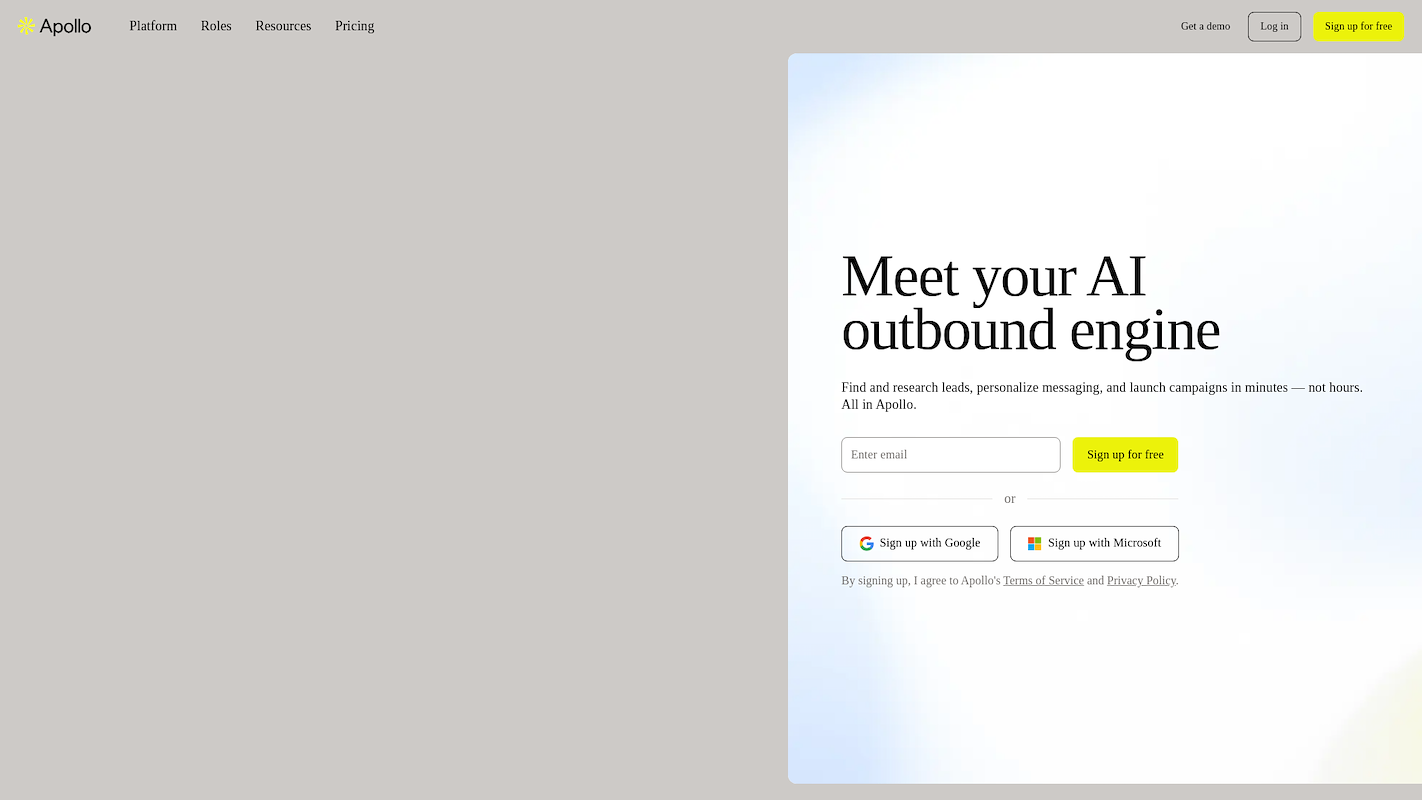
Apollo.io is a sales intelligence and engagement platform for sales and marketing teams. It provides a database with over 275 million contacts and tools to connect with them. Users can find buyers with more than 65 data attributes and use automated sequences across email, phone, and LinkedIn.
The platform also includes functions for pipeline management and performance analysis to support a go-to-market strategy.
Apollo.io's Main Features
- Provides access to a B2B database with over 210 million contacts and 35 million companies for prospecting.
- Includes tools for lead validation and enrichment to ensure data quality and accuracy.
- Uses an intelligence engine to deliver recommendations and analytics that guide go-to-market processes.
- Offers an engagement suite to scale outbound activity and automate outreach sequences effectively.
Apollo.io vs. Smartlead: Key Differences
Average Review Score: 4.7/5 stars based on 8,904 G2 reviews.
- Apollo.io includes a B2B database with over 210 million contacts for prospecting. This is different from Smartlead, where users must import their own lead lists.
- The platform provides an intelligence engine that delivers recommendations and analytics to guide go-to-market processes, offering a layer of strategic guidance not present in Smartlead.
- It offers built-in tools for lead validation and enrichment to ensure data accuracy. In comparison, Smartlead users often need separate tools for data quality management.
- This tool combines a lead database with an engagement suite for outreach. This integrated approach contrasts with Smartlead's specific focus on email account management and warm-up.
Apollo.io vs. Smartlead: Potential Drawbacks
- Apollo.io does not include a master inbox to manage all replies in one place. This can make it harder to handle conversations from many accounts compared to Smartlead, which centralizes all messages.
- Its pricing model is based on a per-user structure. This may become less cost-effective for large-scale outreach than Smartlead, which supports unlimited email accounts.
- Some users report that its email warm-up and deliverability features are less advanced. Smartlead, as a specialized tool, often provides more detailed control over these specific functions.
Pricing and Cost-Effectiveness
Apollo.io offers a free plan and paid options starting at $49 per user per month. This per-user model can be cost-effective for smaller teams, while Smartlead’s structure is often more economical for large-scale outreach since it supports unlimited accounts. For detailed pricing, visit Apollo.io's official website.
9) Snov.io

Snov.io is a sales automation platform with tools for lead generation and email outreach. Users find and verify email addresses, then engage prospects with automated drip campaigns. Sales teams, marketers, and recruiters use the platform to manage outreach and connect with contacts from one place.
Snov.io's Main Features
- Manages sales opportunities and the pipeline.
- Automates sales force tasks and activities.
- Includes reporting and analytics with dashboards.
- Provides access to contact, company, and industry research data.
Snov.io vs. Smartlead: Key Differences
Average Review Score: 4.6/5 stars based on 450 G2 reviews.
- Snov.io includes features to manage sales opportunities and the pipeline directly within the platform. This is different from Smartlead, which focuses on outreach and requires other tools for pipeline management.
- The tool provides access to contact and company data for prospecting. This contrasts with Smartlead, where users must import their own lead lists from external sources.
- It offers sales force automation to manage tasks and activities. This provides a broader range of automation compared to Smartlead, which centers on email campaign execution.
- This platform has reporting and analytics dashboards connected to its sales pipeline. This gives a different view of performance than Smartlead's analytics, which focus on email metrics.
Snov.io vs. Smartlead: Potential Drawbacks
- Snov.io's credit-based system can be a limitation for high-volume sending. This is different from Smartlead, which offers unlimited email accounts for scaling large campaigns without monthly credit caps.
- It can be less efficient to manage replies from multiple campaigns. Unlike Smartlead's master inbox that centralizes all conversations, users might need to check different areas to track all prospect responses.
- Some users report that its email warm-up and deliverability features are less advanced. Smartlead is a specialized tool that often provides more detailed control and analytics for its warm-up functions.
Pricing and Cost-Effectiveness
Snov.io offers plans starting at $39 per month. Its credit-based system can be cost-effective for targeted campaigns, while Smartlead's support for unlimited accounts is often more economical for large-scale outreach. For detailed pricing, visit Snov.io's official website.
10) Klenty

Klenty is a sales engagement platform for sales teams to automate prospect outreach. It helps reps execute multi-channel sequences across email, LinkedIn, and phone calls. The tool focuses on prospect engagement to book more meetings and integrates with popular CRM systems to centralize sales activities.
Klenty's Main Features
- Manages sales tasks and integrated workflows for prospecting automation.
- Provides analytics on open rates, link activity, and workflow performance.
- Integrates with CRMs like Salesforce, Pipedrive, and Hubspot to run custom workflows.
- Includes email scheduling and customization options for outreach campaigns.
Klenty vs. Smartlead: Key Differences
Average Review Score: 4.6/5 stars based on 387 G2 reviews.
- Klenty provides deep integrations with CRMs like Salesforce and HubSpot. This allows for custom workflows, which is different from Smartlead where similar syncs may require other tools.
- It combines email, LinkedIn, and phone calls into multi-channel sequences. This offers more outreach options compared to Smartlead, which focuses primarily on email.
- The platform includes sales task management to help reps prioritize high-value actions. This approach differs from Smartlead's focus on email sending and warm-up automation.
- Its analytics report on workflow performance and prospect engagement. This gives a different view of campaign success compared to Smartlead's analytics, which center on deliverability.
Klenty vs. Smartlead: Potential Drawbacks
- Klenty's per-user pricing model can be less cost-effective for large-scale outreach. In comparison, Smartlead allows unlimited email accounts, which often makes it a more economical choice for teams that manage many inboxes.
- It lacks a master inbox to see all replies in one place. This may make it difficult to manage conversations from many accounts, a task Smartlead simplifies with its centralized inbox feature.
- Some users may find its email warm-up features are less advanced than those in Smartlead. As a specialized tool, Smartlead often provides more detailed control and analytics for its deliverability functions.
Pricing and Cost-Effectiveness
Klenty offers plans from $50 to $100 per user per month. This per-user model can suit smaller teams, while Smartlead's structure, which supports unlimited accounts, is often more economical for large-scale outreach.
Which One Should You Go With?
Choosing a Smartlead alternative depends on many variables. This guide shared several options to help you compare features and find the right fit for your team's specific needs.
For teams interested in digital workers, 11x offers autonomous agents to handle lead research and outreach. This approach lets your sales team focus on closing deals instead of managing manual tasks.




